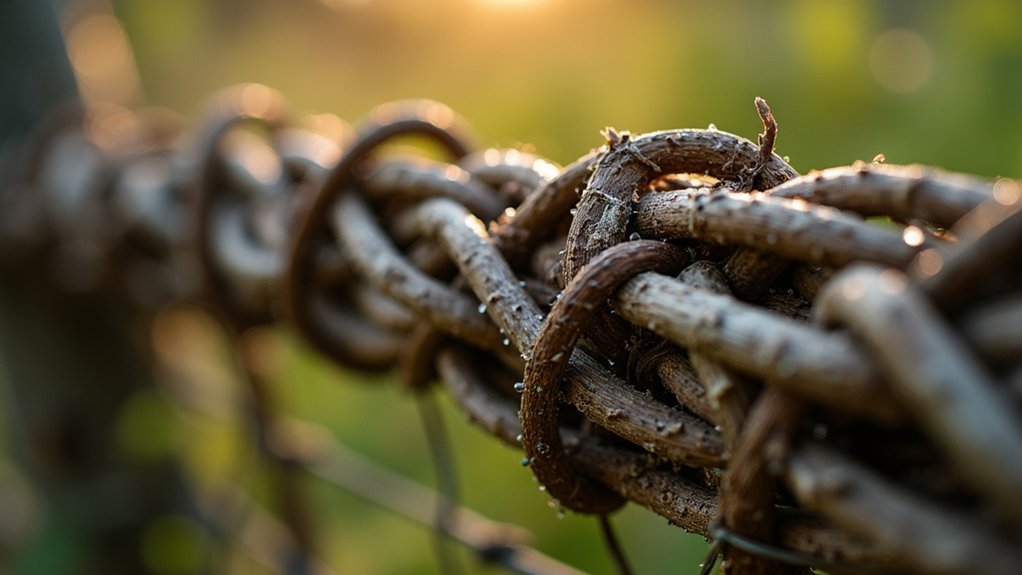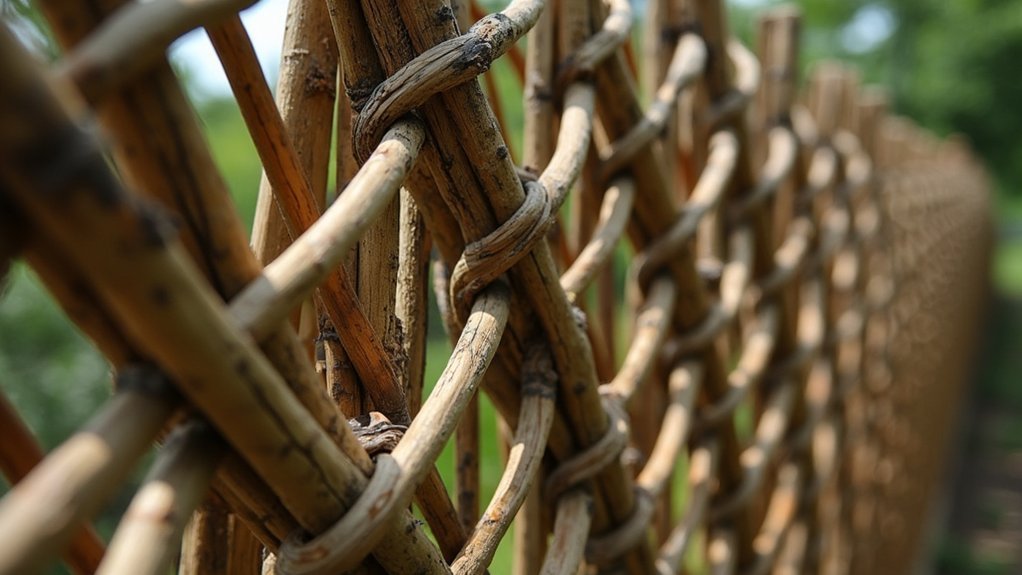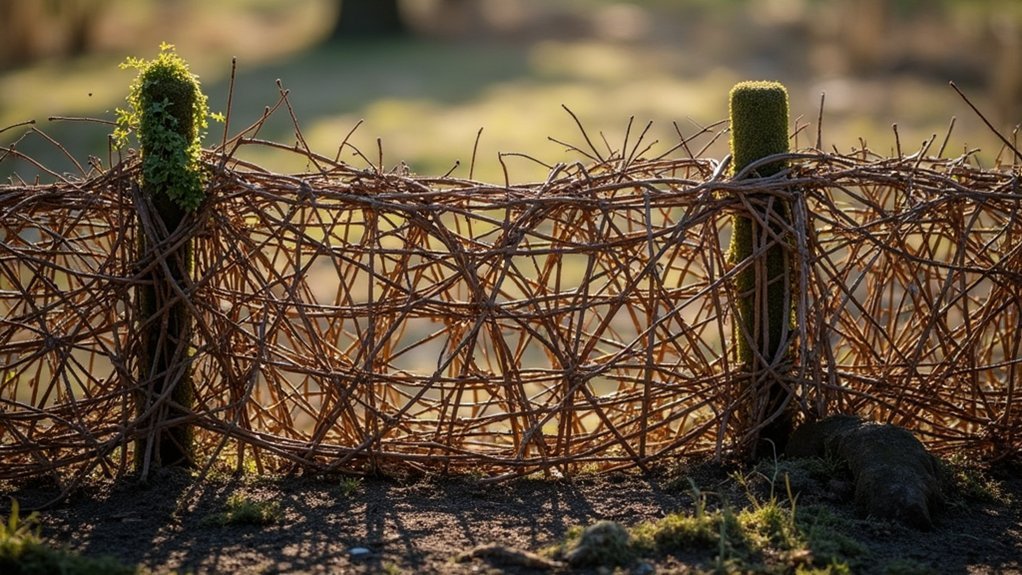Five simple hand-woven wattle fence techniques include the traditional over-under pattern using willow branches, spiral wattle for circular enclosures, double-rod weaving for durability, loose lattice style for decorative screens, and herringbone pattern for wind resistance. You’ll need sturdy stakes spaced 1-6 feet apart and flexible branches for weaving. Each technique offers different benefits depending on your needs, from privacy to garden protection. These time-tested methods bring natural beauty to your landscape while providing practical functionality.
Traditional Over-Under Weaving Pattern

The ancient craft of wattle fencing begins with careful preparation. After driving sturdy stakes 3-6 feet apart around your perimeter, select pliable green branches like willow or hazel for ideal flexibility.
Start weaving by placing your first branch behind one stake and in front of the next, continuing this over-under pattern throughout. Maintain consistent tension as you work in small sections, overlapping branches slightly for a tight structure. For maximum stability, remember to compact weaving every few branches by pushing downward firmly.
Begin each new branch about a foot above where the previous one ended. Establish a solid foundation with thicker branches at the base, then use smaller ones to fill gaps as you build height.
Complete three to four rows across a few posts before moving to the next section. Remember to trim excess material for a neat appearance while closing any gaps that develop during weaving.
Spiral Wattle Technique for Circular Enclosures
Crafting circular enclosures demands a different approach than straight-line fencing, which is why the spiral wattle technique has emerged as the preferred method for round structures. This method relies on thin, flexible materials like willow branches (0.5-1.5″ diameter) woven in a helical pattern.
Begin by installing vertical stakes 12-18″ apart in a circle. Soak your weaving branches for 1-2 hours to increase pliability. Anchor your first weft at a central stake, then weave outward in a spiral, maintaining 60-90° angles at junctions. Similar to circular twill weaving, this technique typically follows an over two, under one pattern to create structural integrity.
Alternate clockwise and counter-clockwise layers to prevent unraveling. For stability, add horizontal braces every 24-36″ and guarantee each spiral rises 2-3″ per rotation.
Consider adding clay daub between weaves for weather resistance, especially in humid environments.
Double-Rod Weaving for Extra Durability

While single-rod wattle fences serve many garden needs adequately, double-rod weaving elevates both strength and longevity of these traditional barriers.
By weaving two rods simultaneously between uprights, you’ll create a denser, more tightly interlocked structure that resists spreading and sagging. This technique requires flexible materials like hazel or willow that can bend without breaking during the weaving process. Hazel is particularly identifiable by its distinctive yellow catkins during early spring.
Double-rod weaving creates denser, stronger barriers using pliable branches that interlock for superior stability and weather resistance.
To implement double-rod weaving effectively:
- Space your upright stakes 10-15 inches apart to properly support the doubled rods.
- Alternate rod direction with each pass, ensuring pairs lock tightly with previous layers.
- Press down firmly on each completed row and twist rods every 3-5 layers to maintain tension.
With proper maintenance, your double-rod wattle fence can remain functional for 7-8 years—nearly twice the lifespan of single-rod versions.
Loose Lattice Style for Ornamental Screens
Unlike strictly functional barriers, loose lattice wattle fencing transforms ordinary garden spaces into visually appealing sanctuaries with their airy, open-weave pattern. You’ll find this style particularly suitable for decorative screens that define spaces without creating a solid barrier.
Select branches under 1 inch in diameter for weaving, while using thicker stakes (1.5+ inches) for vertical support. Space your posts 16-18 inches apart in a jig, then weave flexible willow or hazel branches in a simple over-under pattern. The technique is reminiscent of ancient practices dating back over 6000 years.
| Material | Best Species | Ideal Season |
|---|---|---|
| Stakes | Oak, Chestnut | Winter |
| Weavers | Willow, Hazel | Early Spring |
| Binders | Thin Willow | Spring |
| Decorative | Flowering Vines | Summer |
| Reinforcement | Split Hazel | Fall |
Adjust weave density based on your privacy needs and aesthetic preferences. With proper maintenance, your lattice wattle screen will last 7-10 years.
Herringbone Pattern for Wind-Resistant Fencing

The remarkable herringbone pattern stands as a superior choice for areas prone to high winds, offering both resilience and visual appeal. By weaving thin, flexible saplings diagonally in alternating V shapes, you’ll create interlocking chevrons that distribute wind pressure across multiple points rather than concentrating it in one area.
Begin by placing stakes approximately 18 inches apart and secured 12 inches into the ground.
When weaving, follow these key steps:
- Start from the bottom, weaving diagonally upward on one side, then switch direction across the stakes.
- Maintain tension in each sapling to prevent future sagging in windy conditions.
- Create narrow gaps in the pattern to allow partial airflow while maintaining structural integrity.
This technique makes the fence an excellent wind barrier for exposed garden sites that need protection from harsh elements.
Regularly inspect and tighten loose strands to preserve wind resistance.
Frequently Asked Questions
How Long Will a Wattle Fence Typically Last Before Needing Replacement?
Your wattle fence will typically last 5-15 years before needing replacement. You’ll see longer lifespans in dry climates, with proper maintenance, quality materials, and regular wood preservative treatments extending its durability considerably.
Can Wattle Fencing Withstand Heavy Snow or Ice Accumulation?
Wattle fencing isn’t ideal for heavy snow or ice. You’ll need to use rot-resistant posts, maintain an open weave, and reinforce the structure. Without regular maintenance, the weight will damage your fence over time.
What Native Plants Make the Best Wattle Material in Different Regions?
You’ll find willow works everywhere, but region-specific options include hazel in the Northeast, bull pine in the Pacific Northwest, bamboo in subtropical areas, and coppiced fruit trees in temperate zones.
How Do You Prevent Wattle Fences From Rotting at Ground Level?
You’ll prevent ground-level rot by elevating your wattle fence on gravel, applying wood preservatives to stakes, ensuring proper drainage, and using Denso tape with 55% overlap. Don’t forget regular inspections and maintenance.
Can Wattle Techniques Be Adapted for Indoor Room Dividers?
Yes, you can adapt wattle techniques for stylish indoor dividers. Use dried materials to prevent humidity issues, integrate with your existing décor, and consider adding functional elements like shelves or lighting for practicality and aesthetics.
In Summary
You’ve now mastered five versatile wattle weaving techniques to transform your garden. Whether you’re creating a sturdy boundary with double-rod weaving or an eye-catching screen with herringbone patterns, you’ll find these traditional methods surprisingly accessible. Don’t worry about perfection—each fence’s handcrafted character adds charm to your landscape. With just some flexible branches and a few hours, you’ll create a beautiful, sustainable fence that connects you to centuries of craftsmanship.





Leave a Reply